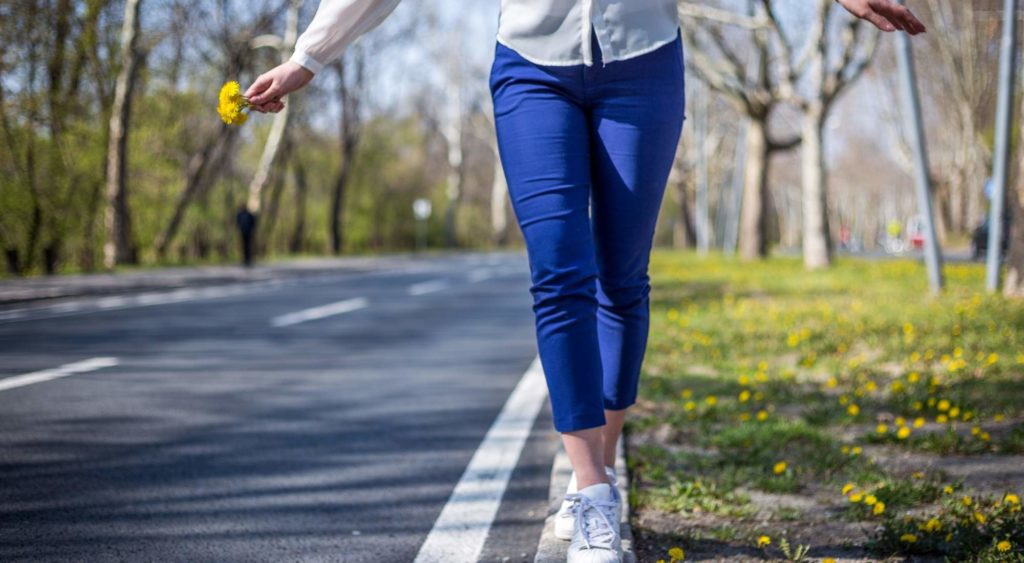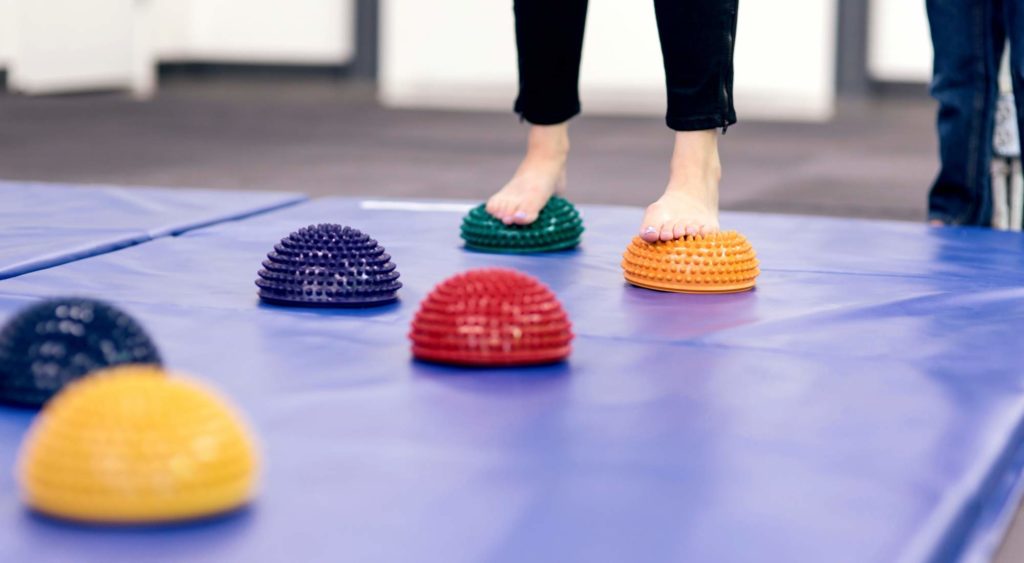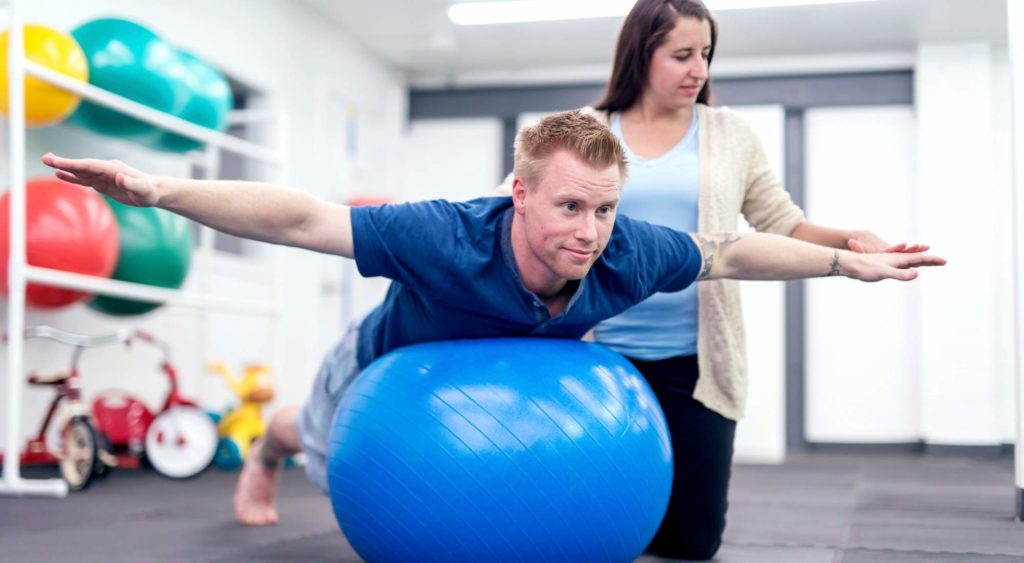
You’ve been struggling with a balance disorder for too long and you’re searching for answers and solutions.
You’ve heard numerous people mention physical therapy for balance problems and you’re wondering, “Can I benefit from going to physical therapy?”
The answer is: Most likely!
In this guide, we’re discussing what causes balance disorders, which balance disorders physical therapy can be most beneficial for, and what physical therapy treatment involves.
Keep reading to learn if physical therapy can help you overcome your balance disorder.
Table of Contents
- What Causes Balance Disorders?
- Treatment Options for Balance Disorders
- Can Physical Therapy Help With Balance Disorders
- 3 Common Balance Disorders Physical Therapy Can Help
- Are You Concerned About Your Balance or Experiencing a Balance Disorder? Our Physical Therapists at In Motion O.C. Can Help

What Causes Balance Disorders?
Balance disorders are defined as conditions that make you feel unsteady or dizzy while:
- Sitting
- Standing; or
- Lying down
Oftentimes, people suffering from a balance disorder may feel like they are moving, spinning, or floating while doing everyday tasks, or even doing nothing at all.
Balance disorders can be caused by a number of things, including:
- Infections of the ear
- Head injuries
- Blood circulation disorders
- Chemical imbalances in the brain
- Low/high blood pressure
- Neurological conditions
- Certain medications; or
- Aging
But for many people, balance disorders come suddenly and may not have any obvious cause — and for many of these balance disorders, physical therapy can be highly beneficial.
Treatment Options for Balance Disorders
Balance disorders are treated differently depending on the cause and any underlying conditions.
First, your doctor will likely take a look at your medications and see if the balance disorder could be caused by any of your medications and may make a dosage change. If your disorder is caused by an infection, your doctor may prescribe antibiotics to solve the problem.
When balance disorders aren’t caused by an underlying condition that requires medical treatment, doctors may recommend more “natural” treatment options, including:
- Exercising
- Diet changes — like limiting caffeine and alcohol intake
- Stopping tobacco use
- Physical therapy
Can Physical Therapy Help With Balance Disorders?
Yes — in fact, physical therapists can help identify the causes of balance disorders and help create a tailored for you treatment plan that may:
- Improve balance
- Increase strength
- Reduce/prevent falls
- And more

3 Common Balance Disorders Physical Therapy Can Help
At In Motion O.C. we treat patients with many different ailments, injuries, and disorders — including balance disorders. Our treatment plans vary based on your specific ailment and needs. Some of the most common balance disorders we treat include:
- Vestibular disorders
- Peripheral neuropathy
- Lower extremity weakness
#1: Vestibular Disorders
One type of balance disorder that can be treated with physical therapy is a type known as a vestibular disorder. Vestibular disorders often come with the following symptoms:
- Unsteadiness
- Wooziness
- Sensations that the ground is moving
- Spinning
- Nausea
- Fatigue
- Lightheadedness
- Swaying
- Tilting
- Tinnitus — ringing of the ears
- Whirling sensations referred to as vertigo
Physical therapists are trained in vestibular rehabilitation therapy (VRT). This specialized physical therapy focuses on the nervous system, specifically the balance component of the nervous system.
VRT is an exercise-based program that can help reduce:
- Vertigo
- Dizziness
- Imbalance and fall occurrences
During VRT, the therapist’s main goal is to help the brain learn to use other senses, such as vision, to compensate for the deficiencies in the vestibular system. This occurs over time, and VRT helps promote this compensation and assist in recovery.
Vestibular Disorder Treatment
Before a physical therapist can help create a comprehensive, individualized program, a clinical examination will be done. Once the evaluation is complete, the physical therapist will choose a method of exercise that best suits your needs.
When treating vestibular balance disorders, physical therapy involves:
- Habituation — best suited for patients with dizziness while moving, changing positions, or reporting dizziness in visually stimulating situations, habituation focuses on repeating specific movements and activities that may provoke symptoms.
- Gaze Stabilization — if a patient is dealing with vision problems when reading, looking around, or walking, this type of VRT may be the most beneficial. During these exercises, physical therapists focus on teaching the eyes to focus without causing dizziness.
- Balance Training — patients who are more prone to falls, like the elderly, may benefit from balance training. During this treatment, a physical therapist will work with the patient to help them perform everyday tasks with less risk of falling.
#2: Peripheral Neuropathy
Balance disorders caused by peripheral neuropathy occur when nerves that carry messages to and from the brain/spinal cord to the rest of your body are damaged. This nerve connects the brain and spinal cord to muscles, organs, and skin.
Common symptoms of peripheral neuropathy include:
- Muscle weakness
- Pain in hands/feet
- Tingling/numbness
- Inability to feel pain or temperature
- Poor balance
Peripheral Neuropathy Treatment
Treatment options for peripheral neuropathy generally focus on relieving pain and treating the underlying condition causing the condition.
When peripheral neuropathy causes balance disorders, physical therapy is a great way to relieve pain and help control associated blood sugar levels to reduce symptoms causing it.
Generally speaking, a physical therapist will help a patient with exercises, including:
- Aerobics
- Balance/Stability
- Flexibility
A physical therapist may also recommend bracing or splints to help with balance and teach patients the best ways to maintain proper range of motion while improving balance.
#3: Lack of Strength in Lower Extremities
One of our four older adults will fall each year, according to the Centers for Disease Control and Prevention.
The cause?
Loss of strength in the lower extremities and balance/gait issues.
Whether from aging, injury, or even living a more sedentary lifestyle — a lack of strength in your lower extremities can cause balance disorders. Physical therapy, especially in cases like this, can be extremely beneficial in helping restore balance and improve gait.
Balance Retraining/Strengthening Exercises and Treatment
Promoting balance and reducing the risk of falls starts with safely doing exercises that strengthen your lower body. A physical therapist can help you by evaluating your balance, recommending exercises tailored to your needs, and teaching you how to properly perform the exercise plan.
Examples of exercises in your balance retraining program may include:
- Tightrope walks
- Flamingo stands (assisted/unassisted)
- Chair leg raises
- Etc.
Before starting any balance retraining or strengthening exercises, it is important that you see a healthcare professional to ensure you’re getting the right treatment for your balance disorder.

Are You Concerned About Your Balance or Experiencing a Balance Disorder? Our Physical Therapists at In Motion O.C. Can Help
Are you experiencing balance problems and still unsure if physical therapy is right for you? We understand how frustrating it can be to find answers and a solution — which is why we’re here to help.
At In Motion O.C., our mission is to give hope, healing, confidence, and joy to others. If you are experiencing any gait issues or balance disorders, one of our experienced physical therapists is here to address your concerns.
Our physical therapists have helped hundreds of people overcome their ailments through customized treatment plans. Contact us today to schedule a free consultation.



